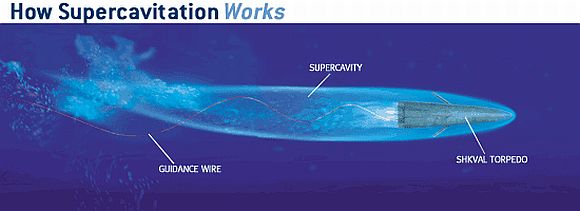 The headline in the South China Morning Post was, at the very least, eye catching — Shanghai to San Francisco in 100 minutes by Chinese supersonic submarine. The article makes it clear that while the Chinese may be researching such a submarine, they are no where close to actually building one. So how does one, even theoretically, build a “supersonic submarine?” The answer may be by using supercavitation. How close are the Chinese to actually designing and building one — not very.
The headline in the South China Morning Post was, at the very least, eye catching — Shanghai to San Francisco in 100 minutes by Chinese supersonic submarine. The article makes it clear that while the Chinese may be researching such a submarine, they are no where close to actually building one. So how does one, even theoretically, build a “supersonic submarine?” The answer may be by using supercavitation. How close are the Chinese to actually designing and building one — not very.
Cavitation is the creation of water vapor bubbles in areas of low pressure on a hull or propeller underwater. In most cases cavitation is something to avoid, if possible. Cavitation bubbles forming and collapsing on a ship’s propeller can damage the blades. The formation and collapse of the bubbles is also noisy, so submarine designers try to design to avoid cavitation in order that submarines be a stealthy as possible. Cavitation also reduces the lift on hydrofoils.
Supercavitation is very different, however. Supercavitation creates a bubble of vapor or gas that completely surrounds an underwater object, such as a torpedo or a submarine’s hull. Because the object isn’t touching the water, supercavitation greatly reduces drag and make very high speeds possible.
As reported by the South China Morning Post: In theory, a supercavitating vessel could reach the speed of sound underwater, or about 5,800km/h, which would reduce the journey time for a transatlantic underwater cruise to less than an hour, and for a transpacific journey to about 100 minutes, according to a report by California Institute of Technology in 2001.
Of course there is a considerable distance between the theory and a practical design. Nevertheless, supercavitation is not particularly new. The Russians started working on a supercavitating torpedo back in the 60s. The Russian VA-111 Shkval supercavitating torpedo went into service in 1977 and is reportedly capable of speeds in excess of 200 knots, far faster than any US or NATO torpedo in service. The US Mark 48 torpedo, for example, is estimated to have a top speed of around 55 knots.
So, if the Russians have had a supercavitating high speed torpedo for almost 40 years, why hasn’t the US Navy built a similar design? The answer is, of course, that they have. The Navy just chose not to deploy it. Supercavitating torpedoes are very fast but they are also very noisy. Firing one immediately reveals the position of the submarine that fired it. They are also not easy to steer or to control remotely. So far, the US Navy has decided to stick with the slower, quieter and more controllable conventional propeller.
The Navy has, however, developed supercavitating bullets to take out underwater mines. The Advanced High Speed Underwater Munition (AHSUM) program has already demonstrated the effectiveness of such high-speed underwater bullets. Fired from an underwater gun, these projectiles have successfully broken the speed of sound in water (1,500 meters per second), bringing their future application much closer to reality. The Navy is already developing a mine-clearance system that uses supercavitating bullets fired from a helicopter. The Rapid Airborne Mine Clearance System (RAMICS) targets mines at shallow depths and delivers bursts of armor-piercing rounds from the air, through the intervening water, and into the mines.
Also back in 2006, the Defense Advanced Research Projects Agency (DARPA) contracted with General Dynamics to design the “Underwater Express,” a minisub capable of traveling at 100 knots. Reportedly, a quarters scale model of the mini-sub was supposed to have been tested in 2010. Rumors are that the design has yet been proven successful.
What may be the closest thing to a fully operational supercavitaing vessel is the Ghost, developed by Juliet Marine, which features a stealth center cabin designed to be invisible to radar, supported on and powered by two supercavitating hulls. Nowhere near supersonic, Ghost can hit close to 30 knots. So far the Pentagon has not been overly enthusiastic over the privately funded design. As reported by Bloomberg: This Stealth Attack Boat May Be Too Innovative for the Pentagon

We can still hear it and that is all that matters.
Very Interesting, this is like the supersonic aircraft, air is a fluid too, a compressible fluid.